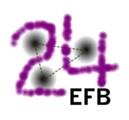According to our present knowledge the modern nucleon-nucleon forces based on the meson-exchange theory are unable to reproduce the experimental data for the systems with A>2. One needs to include additional piece of dynamics in the calculations, so-called three-nucleon force (3NF) [1,2]. To investigate the nature of 3NF the proton-deuteron breakup reaction characterized by very rich...
Detailed measurements of five-fold differential cross sections and a rich set of vector and tensor analyzing powers of the 2H(~d, dp)n break-up scattering process are presented. The data were obtained using a polarized deuteron-beam with an energy of 65 MeV/nucleon impinging on a liquid-deuterium target. The experiment was conducted at the AGOR facility at KVI using the BINA 4π-detection...
One of the most important topics of nuclear physics is to describe various nuclear phenomena based on the nucleon-nucleon interactions combined with three-nucleon forces (3$N$Fs). 3$N$Fs are key elements to understand various nuclear phenomena, e.g. binding energies of light mass nuclei [1] and the equation of state of nuclear matter [2]. In the last decades, the study of 3$N$Fs effects has...
The three-nucleon force (3NF) is essentially important to clarify various nuclear phenomena, such as the binding energy of light mass nuclei [1], the equation of state of nuclear matter [2] and few-nucleon scattering systems [3]. The isospin $T=3/2$ components of the 3NF also play an important role in many-nucleon systems especially for neutron-rich nuclei as well as neutron matter...
